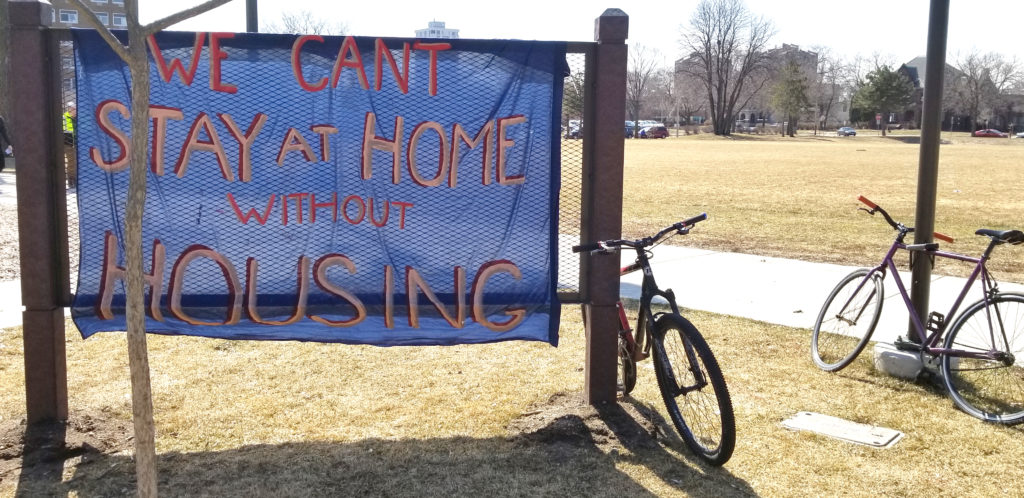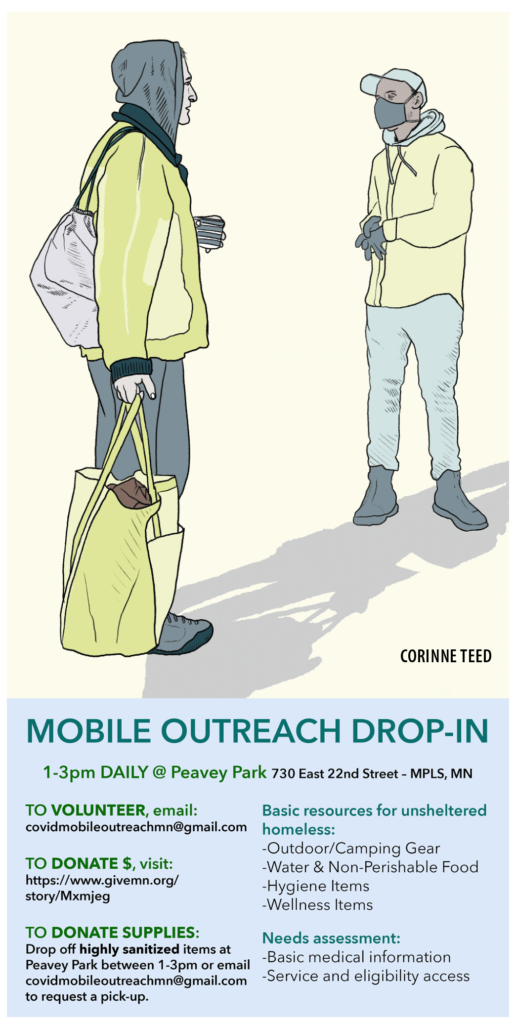by Nicole Sara Simpkins, Sarah Jane Keavney, Cara Carlson, Minkara Tezet

In mid-March, several community practitioners and elders began sharing concerns about our city”™s collective response to Covid-19. In particular, we were concerned for our neighbors who depend on social services, health clinics, and community for their basic needs and safety. We asked ourselves: what will happen when people without housing can”™t access public libraries, or the Midtown Global Market? Where will these community members find health and safety information? How can we continue to offer care and knowledge with the Backyard Community Health Hub closed? How will people stay safe when social distancing isn”™t possible in crowded shelters? What about the 700+ unsheltered people not currently on any priority list for housing and care?
We also asked, what would it be like to answer these questions from the standpoint of cultural and community wellness, informed by the Cultural Wellness Center”™s 21 Principles of Community/Cultural Health Practices? How would this response be different from a state, agency, or hospital system response? Where would the resources, expertise, and support come from?
When systems are tasked with providing care, words like prioritization, eligibility, service delivery, and vulnerability describe how we respond to human needs. Within systems, people become symptoms, risk, percentages. When a community is tasked with providing care, words like context, inherent, tending, relationship, and reflective describe how we experience our health together. People become their capacity, their wisdom, their healing.
The principles of cultural wellness teach us that a “tremendous amount of healing takes place when people take responsibility for their own healing and the healing of their community and when the community takes responsibility for the healing of its members” (Principle 4). Principles 8 and 9 teach us:
Ӣ Emphasize prevention over treatment and teach that prevention must involve the whole community.
Ӣ View illness as affecting a person within the context of a whole community, not as an isolated event.

The “Mutual” in Mutual Aid
We began to deepen our practice of these principles in mid-March, by showing up to Peavey Park every day from 1-3 PM. We call ourselves The Mobile Outdoor Outreach Drop-In (MOODI), and we offer a practice of mutual aid and community care. We”™re focused primarily on our neighbors without shelter – members of our community who exist outside of the systems tasked with providing care. We bring what we know about cultural and community wellness. This includes the cultural practice of hospitality: we offer tea, coffee and hot chocolate, snacks, warm clothing, personal hygiene and wellness supplies, information, knowledge about how to care for ourselves while experiencing stress, connection to on-site needs assessment for medical care, assistance with seeking aid, harm reduction items, and, most importantly, presence: care in community.
We recognize the “mutual” in mutual aid – as we, ourselves, experience the mending that takes place when we gather material and cultural resources to share. “We” include teachers, practitioners and learners from the Cultural Wellness Center and Anam Cara; outreach workers from agencies and organizations; activists and community organizers, volunteers and professionals, herbalists, and people who live and care in a web of overlapping communities. The cultural resources come from ourselves, our bodies, our hearts and spirits, our training and expertise, our resilience and our networks. The material resources come from our connections with people who recognize our shared humanity and who are able to share their excess and abundance. We ask, we talk, and we offer to redistribute.
We are mindful of what it means to show up to this work during a pandemic. If we do not apply the principles of care, wellbeing, and “best practices for safety” when it comes to our own health, we will undermine our work. In truth, we are only ever as safe as the most vulnerable people in our communities. In this time of Corona, we encounter this stark truth in a new way: we are not separate beings. When we keep ourselves safe from exposure to the virus, we keep our community safe. When we provide increased safety to our community, we keep ourselves safe.
MN ”˜Shelter-In-Place Order
On Friday, March 27, Governor Walz issued what is now referred to as a “Shelter-in-place” order: all persons currently living within the State of Minnesota are asked to stay at home, unless to engage in essential services. As community care practitioners, we gathered in the park after this announcement, standing in a very wide circle, with 6 feet between each of our bodies, and attempted to figure out what this might mean for us and the people we are caring for. We figured out that yelling across the space with our homemade masks wasn”™t going to get us far, so we started meeting weekly online to support our on-site work.
Waltz”™s order contains the following note: “Individuals without a home are exempt from the restrictions in this Executive Order, and they may move between emergency shelters, drop-in centers, and encampments. Encampments should not be subject to sweeps or disbandment by state or local governments, as such sweeps or disbandment increase the potential risk and spread of COVID-19.”

Community Responsibility for Safety
As days and weeks pile toward months ahead, we continue to question what it means to take community responsibility for safety during this time. We know that, pre-Corona, there were inadequate shelter beds, a housing crisis, and pre-existing outbreaks of disease and poor health. We know that community members experiencing these conditions are disproportionately black, indigenous and people of color. We know that in actuality, this systemic scarcity is a creation; in factual reality, there are enough rooms, beds, meals and money within our city to house and nourish all of us. Pandemic conditions heighten the brittleness of what has been.
We continue to show up in the park from 1-3 each day, practicing an attitude of cultural dignity and community connection (Principle 15) as we care for one another. We continue to reflect on what is needed during this time. As we seek to address the concerns that first brought us together, we are asking, how can this moment become a chance for healing and learning? How can we see cracks where the light gets in to provoke shifts toward truthful, stronger, and lasting wellness?
These questions spin threads that strengthen us toward becoming a community in service to itself. CWC Principle 7 teaches us, “Present, when possible, lifestyle changes and renewed decision-making within a cultural context as preferable to clinical options.” This is how we are showing up with a renewed sense of purpose – out of concern for the lived conditions of our neighbors, friends, family, and ourselves – we become a community who cares for itself.










